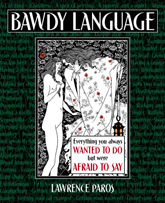
M’lady’s privates consist of a number of parts. Those which are featured most prominently are the vulva1 (c. 1548, Latin for “wrapper”), and the vagina2 (c. 1682, Latin for “sheath”). However, the whole world knows them better collectively as the cunt.
Cunt is a grand old word, not underground, not slang. You’ll find variations of it in Old and Middle English, Middle Low and Low German, Old Norse, and Dutch. For years, it was believed that cunt derived from cunnus, the Latin word for the female genitals, but no one could explain how the t got into cunt. It was left for Eric Partridge to discover the word as related to the Old English cwithe, “womb,” finding the root of the matter in cwe, (or cu), which signifies “quintessential physical femininity”—a root that appears in a host of words from “cradle” and “cow” to “queen” and “cunning.”
Cunt has been taboo in writing and in speech since the fifteenth century. Between 1700 and 1959 it was considered obscene, and it was a legal offense to print it in full.
No ordinary four-letter word, cunt’s always been rather special. It’s a “sexual energizing word,” one which, according to Partridge, conveys “the sexual pleasure produced by a woman in a man and indeed all that woman-as-sex signifies to a man both physically and spiritually.”
It’s a cavern of joy you are thinking of now A warm, tender field just awaiting the plow.
It’s a quivering pigeon caressing your hand
Or that sweet little pussy that makes a man stand
Or perhaps it’s a flower, a grotto, a well, The hope of the world, or a velvety hell.
But friend, heed this warning, beware the affront
Of aping a Saxon: don’t call it a cunt.
—“Ode to Those Four-Letter Words”
Read more – “Bawdy Language,” the Book



Leave a Reply